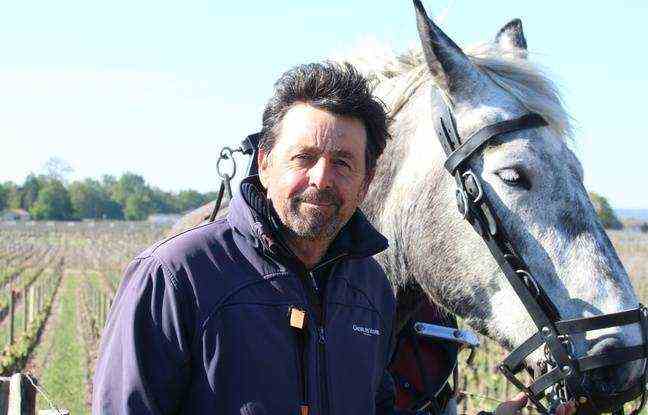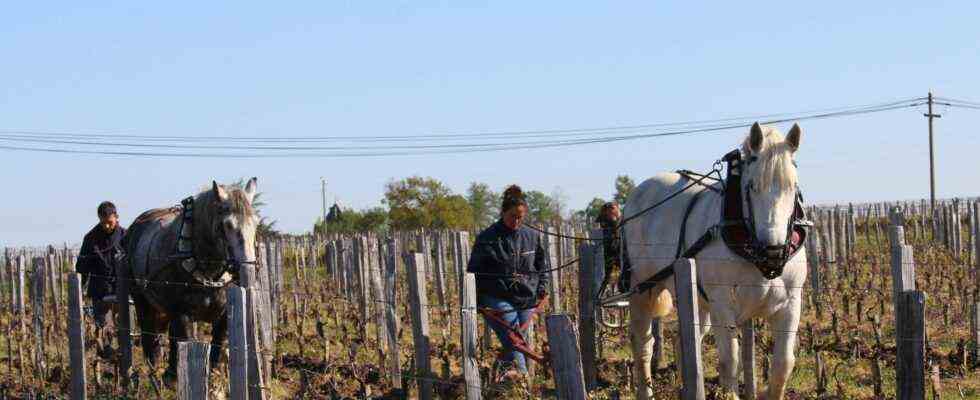Bordeaux: Horse-drawn plowing is making a comeback in the vineyards – 20 minutes
- In Saint-Emilion, the family business Cheval des Vignes works on behalf of around forty wine châteaux.
- Far from folklore, this practice of plowing on horseback represents a real interest in the treatment of certain plots of vines.
- The renewed interest is so strong that a school of horse winegrowers has just been created in Saint-Emilion.
Do not tell him especially that it is “the return of work to the old.” “Or that” we are coming back to common sense peasant. “It is so not representative of what we do”, annoys Juliette Bouetz, the communications manager of the family business Cheval des Vignes, created near Saint-Emilion ten years ago by her father. , Sébastien Bouetz.
All dressed in a sweater branded with the name of the company, Sébastien Bouetz and his three daughters practice plowing on horseback in the vines which is resolutely modern. And the small business has become more professional over the years, going from two to twelve horses, only Percherons. She now works for around forty properties on the right bank, which represents close to 70 hectares to cover during the season.
“Our horses are real athletes”
“Yes, we are returning to ancestral values, concedes Juliette Bouetz, but we have modernized the activity like never before. For example, we do not use old plows, we build our tools. And the days of swinging horses in a meadow at the end of the working day are over. Our horses today are real athletes, they do balneotherapy, they see the osteopath every month, they are followed by a veterinarian, a dentist… And they never do more than four hours of work in a row. “
Son of a winegrower and technical director in a vineyard for sixteen years, Sébastien Bouetz would never have imagined ten years ago that his career would rebound behind a horse. “I’ve always liked being down to earth, and at the same time I was an amateur rider, so when I stumbled upon a demonstration of animal traction, it clicked. Three months later I bought my first two mares and started the adventure. But without knowing if it was going to take or not. “

“At the beginning we said that castles did this for photography”
It took so much that the providers of draft horses have since multiplied. In Lalande-de-Pomerol, Susana Teixeira is also one of the pioneers of animal traction in the region. She set up her business, Cheval et Vignes, in 2012 and now operates around ten horses. She takes care of a dozen wine estates, including three regularly. “At the beginning we talked a lot about fashion effects,” she recalls, “we used to say that castles did just that for photography. But gradually the interest of the horse was imposed on several properties, for different types of work, because it is good for the soil and it avoids chemical weedkillers in particular. “
Far from being a simple folk activity, “the use of the horse has developed a lot,” confirms Sara Briot Lesage, at the Interprofessional Bordeaux Wine Council (CIVB). Some properties have acquired horses but most entrust this service to specialized companies. “
Some use other animals, such as oxen. “Oxen have more strength than horses but are not very resistant,” continues Sara Briot Lesage. And when the oxen are tired, they don’t hesitate to lie down in the row of vines! There are also mules which are interesting because they have the same resistance as horses and are agile and able to move in very steep terrain. But compared to these animals, the horse remains largely dominant in the vineyards. “
A horse-winemaker school opened in 2019
Proof that a real sector is in the process of being structured, a school of horse winegrowers was even set up at the end of 2019. This is an initiative of the association of horse breeders of Nouvelle-Aquitaine, and of the French working equine society. The school is hosted at Château Soutard in Saint-Emilion. “After an almost blank year in 2020, we just resumed last February,” explains training manager Ombeline Baron, who currently welcomes around ten trainees. We train horses to work in the vineyard, because it is learned to know how to walk well in the row, to be attentive … We also supervise people, with the idea of training pairs when they arrive. , to support winegrowers or service providers who want to get started in this activity. “
This school was created “in the face of renewed interest in the use of horses in the vineyards, when there was no longer any training. In particular, we have been contacted by vineyards looking for employees, or service providers, and who cannot find them. This was the case with Château Soutard for example, with whom we decided to set up this school together. “
“On the old vines, the horse does an extraordinary job”
However, the horse remains confined to very specific tasks, and never treats the entire vineyard of a domain. “In tillage, there is plowing and stripping,” explains Olivier Bernard, manager of the Domaine de Chevalier in Léognan, which uses horses and mules. Plowing consists of taking the soil in the middle and putting it in the row, and stripping is taking the soil out of the row to put it back in the middle. It is mainly for the stripping that one calls on the horse, because it is necessary to work according to the vine stock, and the horse turns out to be very precise. On old vines, in particular, he does an extraordinary job, because where the plow behind the tractor can catch a foot and pull it out, the horse feels resistance and stops. Knowing that an old vine that produces a great wine costs several hundred euros, there is therefore a real reasoning behind. “
“We also call on us when there is a mechanical problem,” adds Sébastien Bouetz. This is the case at Château Beauregard in Pomerol. To densify its plantations, the estate has decided to replant narrower vines, with spacings of 1.10 meters instead of 1.50 meters traditionally. “This implies modifying our fleet of equipment, since we have to equip ourselves with straddles instead of our vineyard tractors,” explains Guillaume Fedoux, technical director of Beauregard. While waiting for the renewal of this material, we switched to horses, knowing that they represent another asset, it is respect for these young vines that we are in the process of replanting. “
A zero carbon footprint
“We are working on precision,” insists Juliette Bouetz, “and the other advantage of the horse is that it weighs only one ton, when the tractor does between four and eight. Thus, the animal does not compact the soil, and all microbial life is preserved. Finally, it represents a zero carbon footprint. It is for all these things that the horse develops. However, we are not anti-tractors, because there are things the horse will never be able to do. “
Is it more expensive for all that? At Château Beauregard as at Domaine de Chevalier, we recognize that it is. “This represents a fairly significant cost, and we optimize more with tractors that can handle two rows simultaneously,” explains Guillaume Fedoux. “Work on horseback is necessarily slower”, emphasizes Olivier Bernard. Sébastien Bouetz tries to convince otherwise. “For clearing, we move as fast as a tractor,” he says. And when a tractor costs between 80 and 100 euros an hour, we are at 65 euros. On very qualitative plots, we have a real interest. Some properties have understood this well.
On the occasion of Agriculture Week in New Aquitaine, a conference on the horse in the vineyard will be held on May 17 at Château Soutard, which will be broadcast online on the show website.

